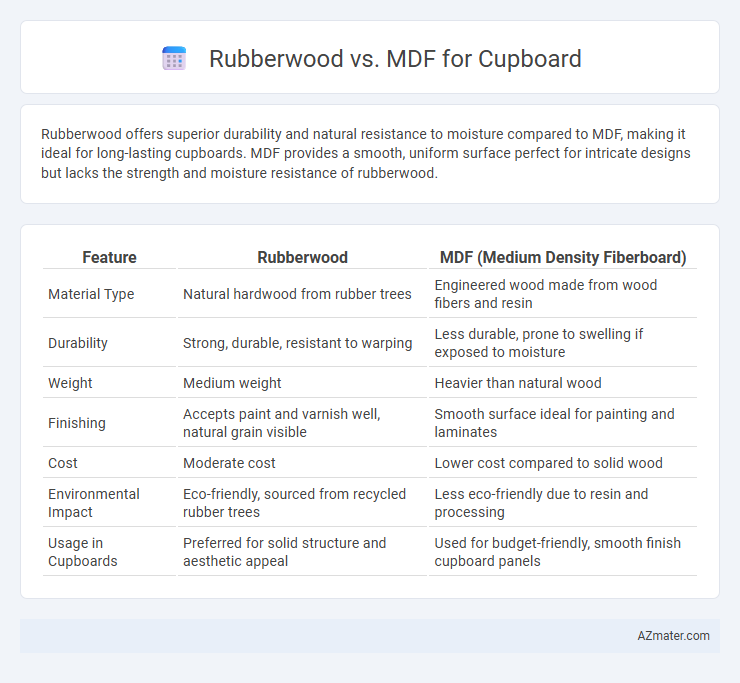Rubberwood offers superior durability and natural resistance to moisture compared to MDF, making it ideal for long-lasting cupboards. MDF provides a smooth, uniform surface perfect for intricate designs but lacks the strength and moisture resistance of rubberwood.
Table of Comparison
| Feature | Rubberwood | MDF (Medium Density Fiberboard) |
|---|---|---|
| Material Type | Natural hardwood from rubber trees | Engineered wood made from wood fibers and resin |
| Durability | Strong, durable, resistant to warping | Less durable, prone to swelling if exposed to moisture |
| Weight | Medium weight | Heavier than natural wood |
| Finishing | Accepts paint and varnish well, natural grain visible | Smooth surface ideal for painting and laminates |
| Cost | Moderate cost | Lower cost compared to solid wood |
| Environmental Impact | Eco-friendly, sourced from recycled rubber trees | Less eco-friendly due to resin and processing |
| Usage in Cupboards | Preferred for solid structure and aesthetic appeal | Used for budget-friendly, smooth finish cupboard panels |
Introduction: Rubberwood vs MDF for Cupboards
Rubberwood, derived from the Para rubber tree, offers natural durability and eco-friendliness, making it a prime choice for cupboard construction. MDF (Medium Density Fiberboard) provides a smooth, uniform surface ideal for detailed finishes but lacks the strength and moisture resistance of Rubberwood. Choosing between Rubberwood and MDF depends on priorities like durability, cost, and environmental impact for cupboard applications.
Material Overview: What is Rubberwood?
Rubberwood, also known as plantation hardwood, is a sustainable material harvested from rubber trees after their latex-producing lifecycle ends, offering a durable and eco-friendly option for cupboards. Its natural grain and resistance to warping make it preferable for furniture requiring structural stability and aesthetic appeal. Rubberwood's strength and ability to absorb finishes enhance its performance compared to engineered materials like MDF.
Material Overview: What is MDF?
Medium Density Fiberboard (MDF) is an engineered wood product made from wood fibers, wax, and resin compressed under high temperature and pressure, resulting in a dense, smooth, and uniform panel. MDF is prized for its affordability, ease of machining, and ability to hold paint well, making it a popular choice for cupboard doors and cabinetry. Its consistent texture and lack of wood grain reduce the risk of warping, but MDF is less moisture-resistant compared to natural wood like rubberwood.
Durability Comparison: Rubberwood vs MDF
Rubberwood offers superior durability for cupboards due to its dense hardwood fibers and resistance to warping, making it ideal for heavy-use environments. MDF, composed of compressed wood fibers, tends to be less durable and more susceptible to moisture damage and sagging under weight over time. Choosing Rubberwood ensures longer-lasting structural integrity and better wear resistance compared to MDF in cupboard construction.
Aesthetic and Finish Differences
Rubberwood offers a natural, warm grain pattern that enhances the aesthetic appeal of cupboards with a smooth, polished finish, making it ideal for visible, high-end furniture. MDF provides a uniform, smooth surface perfect for painted finishes and intricate designs but lacks the natural wood texture and character found in rubberwood. The choice between rubberwood and MDF depends on whether the priority is natural beauty and grain visibility or consistent, customizable finishes.
Cost Analysis: Rubberwood vs MDF
Rubberwood is generally more expensive than MDF due to its natural durability, sustainability, and aesthetic appeal, making it a premium choice for cupboard construction. MDF, being a manufactured wood product made from wood fibers and resin, offers a cost-effective solution ideal for budget-conscious projects but lacks the robustness and longevity of rubberwood. Considering long-term value, rubberwood's higher initial investment often translates to better wear resistance and maintenance savings compared to the frequent replacement or refinishing MDF might require.
Environmental Impact and Sustainability
Rubberwood is a sustainable choice for cupboards due to its origin as a byproduct of rubber tree plantations, which promotes reforestation and reduces waste. MDF, while versatile, often relies on formaldehyde-based resins and synthetic adhesives, raising environmental concerns regarding volatile organic compound (VOC) emissions. Choosing rubberwood supports eco-friendly practices by utilizing renewable resources and minimizing harmful chemical exposure in indoor environments.
Maintenance and Longevity
Rubberwood offers superior durability and resistance to warping compared to MDF, making it ideal for long-term cupboard use with minimal maintenance. MDF is more prone to moisture damage and swelling, requiring careful sealing and regular upkeep to extend its lifespan. Rubberwood's natural strength ensures cupboards maintain structural integrity over years, whereas MDF needs consistent attention to prevent wear and tear.
Suitability for Cupboard Designs
Rubberwood offers superior durability and natural resistance to warping, making it ideal for high-quality, long-lasting cupboard designs. MDF provides a smooth, uniform surface perfect for intricate painted finishes and modern, minimalist styles but is less moisture-resistant. Choosing between Rubberwood and MDF depends on the desired cupboard aesthetic, durability requirements, and environmental conditions.
Final Verdict: Choosing Between Rubberwood and MDF
Rubberwood is durable, eco-friendly, and offers natural wood grain that enhances cupboard aesthetics, making it ideal for longevity and a premium look. MDF provides a smooth surface for painting and is cost-effective but lacks the strength and moisture resistance of Rubberwood, which may result in lower durability. For cupboards requiring robust structure and a natural finish, Rubberwood is the superior choice, while MDF suits projects with budget constraints and a focus on uniform surface finishes.

Infographic: Rubberwood vs MDF for Cupboard
 azmater.com
azmater.com